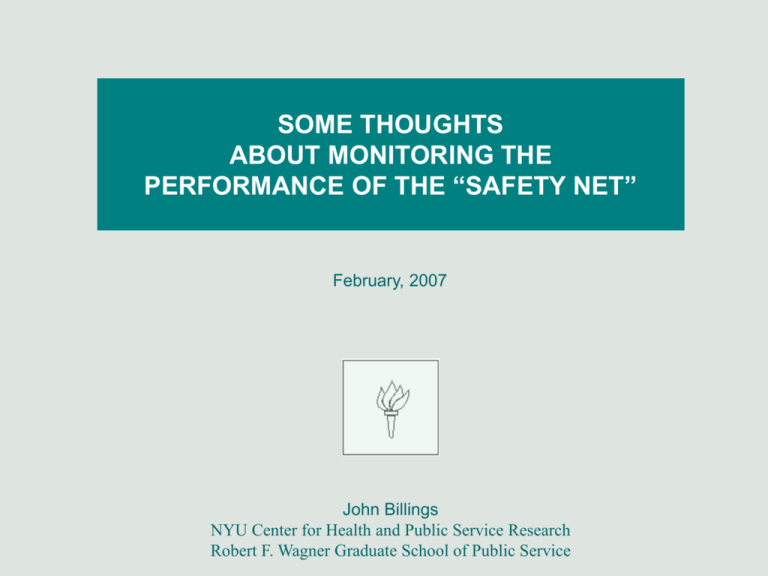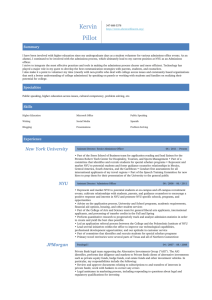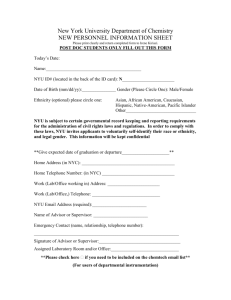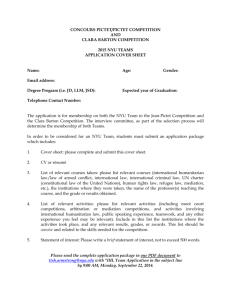ACS Admissions/1000 By Zip Code Area Income New York City
advertisement

SOME THOUGHTS ABOUT MONITORING THE PERFORMANCE OF THE “SAFETY NET” February, 2007 John Billings NYU Center for Health and Public Service Research Robert F. Wagner Graduate School of Public Service WHAT I’M GOING TO TALK ABOUT • Why the focus on “performance” of the safety net? – Some caveats and definitions – Some assumptions • Some examples of using administrative data to monitor performance • The limitations of using administrative data • A few suggestions (unsolicited advice) SOME CAVEATS AND DEFINITIONS • The focus of policy should be on: Assuring optimal health for vulnerable populations • We need to worry about the resources required to assure optimal health of vulnerable populations • These resources are the “safety net” • Because resources are limited, it makes sense to examine the performance of this “safety net” • But it is important to remind ourselves that this isn’t really a “safety net” – We are flying without a net – No one is particularly safe SOME ASSUMPTIONS • Texas is unlikely to enact a universal coverage initiative this year, or next year, or the year after that… • There are lots of opportunities to improve health of vulnerable populations in addition to buying coverage or subsidizing care • Therefore, it is critical to have a monitoring capacity • There is probably not a lot of money around for monitoring things • But it is critical to recognize the inherent limits of administrative data COMPUTERIZED HOSPITAL DISCHARGE AND ED VISIT DATA Preventable/Avoidable Hospitalizations Ambulatory Care Sensitive (ACS) Conditions Conditions where timely and effective ambulatory care help prevent the need for hospitalization • Chronic conditions – Effective care can prevent flare-ups (asthma, diabetes, congestive heart disease, etc.) • Acute conditions – Early intervention can prevent more serious progression (ENT infections, cellulitis, pneumonia, etc.) • Preventable conditions – Immunization preventable illness ACS Admissions/1,000 By Zip Code Area Income New York City - Age 18-64 - 2004 50 Adms/1,000 45 R2 = .622 LowInc/HiInc = 3.65 Coef Vari = .536 Mean Rate = 16.08 40 35 30 25 20 15 10 5 Each represents a zip code 0 0% 10% 20% 30% 40% Percent of Households with Income <$15,000 Source: NYU Center for Health and Public Service Research 50% 60% New York City ACS Admissions/1,000 Age 18-64 - 2004 ACS Admissions/1,000 Age 18-64 - 2004 25 to 47 18 to 25 12 to 18 8 to 12 4 to 8 Unpopulated Areas Source: NYU Center for Health and Public Service Research (29) (27) (53) (39) (26) (3) NYU EMERGENCY DEPARTMENT CLASSIFICATION ALGORITHM 1.0 Not preventable/avoidable ED Care Needed Preventable/avoidable Emergent Primary Care Treatable Non-Emergent New York City ED Utilization Profile Adults Age 18-64 - 1998 ED Needed Preventable Avoidable 7.1% Emergent - Primary Care Treatable 34.4% Source: NYU Center for Health and Public Service Research - UHFNYC ED Needed - Not PreventableAvoidable 18.8% Non-Emergent 39.7% Bronx Percent of Non-Admitted Emergency Department Visits That Are "Non-Emergent" Medicaid - 1998 All Ages Queens Manhattan Brooklyn Staten Island % ED Visits Non-Emergent Medicaid - 1998 45% to 54% 42% to 45% 40% to 42% 20% to 39% Unpopulated Areas (28) (67) (64) (15) (3) UNDERSTANDING THE CAUSES OF VARIATION IN ACS RATES AND ED USE • Theory 1: It’s just New York City – [Who cares] – [You’re more or less a different country] ACS Admissions/1,000 By Zip Code Area Income Baltimore - Age 18-64 - 1999 60 R2 = .899 LowInc/HiInc = 3.90 Mean Rate = 16.93 Adms/1,000 50 40 30 20 10 Each represents a zip code 0 0% 10% 20% 30% 40% % Housholds Income < $15,000 Source: NYU Center for Health and Public Service Research 50% 60% ACS Admissions/1,000 By Zip Code Area Income St. Louis - Age 18-64 - 1999 60 R2 = .870 LowInc/HiInc = 3.50 Mean Rate = 12.53 Adms/1,000 50 40 30 20 10 Each represents a zip code 0 0% 10% 20% 30% 40% % Housholds Income < $15,000 Source: NYU Center for Health and Public Service Research 50% 60% ACS Admissions/1,000 By Zip Code Area Income Memphis - Age 18-64 - 1999 50 R2 = .887 LowInc/HiInc = 2.95 Mean Rate = 14.45 Adms/1,000 40 30 20 10 Each represents a zip code 0 0% 10% 20% 30% 40% 50% % Housholds Income < $15,000 Source: NYU Center for Health and Public Service Research 60% 70% ACS Admissions/1,000 By Zip Code Area Income San Diego - Age 18-64 - 1999 30 R2 = .650 LowInc/HiInc = 3.09 Mean Rate = 7.16 Adms/1,000 25 20 15 10 5 Each represents a zip code 0 0% 10% 20% 30% % Housholds Income < $15,000 Source: NYU Center for Health and Public Service Research 40% 50% ACS Admissions/1,000 By Zip Code Area Income HOUSTON MSA - Age 18-64 - 2002 80 R2 = .561 LowInc/HiInc = 2.71 Mean Rate = 14.57 70 Adms/1,000 60 50 40 30 20 10 Each represents a zip code 0 0% 10% 20% 30% 40% 50% % Housholds Income < $15,000 Source: NYU Center for Health and Public Service Research 60% 70% ACS Admissions/1,000 By Zip Code Area Income Denver - Age 18-64 - 2002 30 Adms/1,000 R2 = .709 LowInc/HiInc = 2.61 Mean Rate = 9.10 20 10 Each represents a zip code 0 0% 5% 10% 15% 20% 25% % Housholds Income < $15,000 Source: NYU Center for Health and Public Service Research 30% 35% ACS Admissions/1,000 By Zip Code Area Income Portland, OR - Age 18-64 - 1999 40 R2 = .739 LowInc/HiInc = 4.26 Mean Rate = 7.69 Adms/1,000 30 20 10 Each represents a zip code 0 0% 10% 20% 30% % Housholds Income < $15,000 Source: NYU Center for Health and Public Service Research 40% 50% SOUTH CAROLINA ED Utilization Profile Adults Age 18-64 - 1997 ED Needed Preventable Avoidable 7.1% Emergent - Primary Care Treatable 42.3% Source: NYU Center for Health and Public Service Research ED Needed - Not PreventableAvoidable 18.8% Non-Emergent 31.9% Preventable/Avoidable ED Use/1,000 By Zip Code Area Income Austin Metro Area - Age 0-17 - 2000 Austin Metro Area Preventable/Avoidable ED Visits Per Capita Children - Age 0-17 - 2001 300 to 546 200 to 300 120 to 200 60 to 120 12 to 60 Low Population Area* (17) (13) (16) (14) (15) (4) UNDERSTANDING THE CAUSES OF VARIATION IN ACS RATES AND ED USE • Theory 1: Who cares? It’s just New York • Theory 2: It’s really pretty complicated – – – – – Coverage barriers Resource supply/capacity Economic barriers Provider performance Quasi-economic barriers • Transportation • Child care • Lost wages – – – – – Barriers to social care Limitations in community social capital Limitations in personal social capital Education, motivation, confidence, health beliefs Physician practice style (Wennberg et al), etc, etc ACS Admissions/1,000 Zip 10016 and Citywide Rates New York City - Age 0-17 – 1982-2001 Adms/1,000 65 60 55 50 45 40 35 30 25 20 15 New York City 10 Zip 10016 5 0 82 83 84 85 86 87 88 89 90 91 92 93 Source: SPARCS - NYU Center for Health and Public Service Research - UHFNYC 94 95 96 97 98 99 00 01 ACS Admissions/1,000 By Zip Code Area Income New York City - Age 18-64 - 2002 50 Adms/1,000 45 R2 = .622 LowInc/HiInc = 3.65 Coef Vari = .536 Mean Rate = 16.08 40 35 30 25 20 15 10 5 Each represents a zip code 0 0% 10% 20% 30% 40% Percent of Households with Income <$15,000 Source: NYU Center for Health and Public Service Research 50% 60% Bronx Percent of Non-Admitted Emergency Department Visits That Are "Non-Emergent" Medicaid - 1998 All Ages Queens Manhattan Brooklyn Staten Island % ED Visits Non-Emergent Medicaid - 1998 45% to 54% 42% to 45% 40% to 42% 20% to 39% Unpopulated Areas (28) (67) (64) (15) (3) Bronx Percent of Non-Admitted Emergency Department Visits That Are "Non-Emergent" Selfpay/Uninsured - 1998 All Ages Queens Manhattan % ED Visits Non-Emergent Brooklyn Staten Island Self pay /Uninsured - 1998 45% to 54% 42% to 45% 40% to 42% 22% to 39% Unpopulated Areas (19) (51) (75) (29) (3) ACS Admissions/1,000 By Zip Code Area Income Miami - Age 18-64 - 1999 50 R2 = .330 LowInc/HiInc = 1.89 Mean Rate = 14.82 Adms/1,000 40 30 20 10 Each represents a predominantly Cuban-American zip code 0 0% 10% 20% 30% 40% 50% % Housholds Income < $15,000 Source: NYU Center for Health and Public Service Research 60% 70% ACS Admissions/100,000 By Ward Code and Deprivation Index London, UK - Age 15-64 - 2001/2-2002/3 2500 R2 = .387 HighDI/LowDI = 2.10 Mean Rate = 881.0 Adms/100,000 2000 1500 1000 500 Each “♦” represents a ward 0 0 10 20 30 40 50 Deprivation Index Note: All data are for 2001/2 and 2002/3 60 70 80 ACS Admissions/1,000 Low and High Income Areas Admissions Per 1,000 New York City MSA – Age 40-64 Adms/1,000 80.0 70.0 Low Income Areas 60.0 50.0 40.0 30.0 High Income Areas 20.0 10.0 0.0 82 83 84 85 86 87 88 89 90 91 92 Source: NYU Center for Health and Public Service Research 93 94 95 96 97 98 99 00 01 02 03 04 ACS Admissions/1,000 Low and High Income Areas Admissions Per 1,000 New York City – Age 0-17 Adms/1,000 40.0 30.0 $50,000,000 Low Income Areas 20.0 High Income Areas 10.0 0.0 82 83 84 85 86 87 88 89 90 91 92 Source: NYU Center for Health and Public Service Research 93 94 95 96 97 98 99 00 01 02 03 04 WHAT’S GOING ON HERE? 1. It isn’t anything 2. It is something: • It’s an improvement in clinical medicine (e.g., asthma) • Changes in composition of NYC’s low income population • It’s related to changes in the factors that contribute to health disparities – – – – – Coverage expansion (???) Supply expansion (???) Service improvement: greater “competition for patients” Changes in social context Etc, etc, etc… Change in ED Visits/1,000 New York City Medicaid FFS – ADC/HR Girls Age 6mos-14yrs 1994-1999 % Change (Log Scale) +100% - +50% - +25% - Injuries -20% - Asthma ACS - No Asthma -33% - -50% 94 95 Source: NYU Center for Health and Public Service Research 96 97 98 99 Change in Percent of ED Visits Resulting In Admission New York City Medicaid FFS – ADC/HR Girls Age 6mos-14yrs 1994-1999 % Change (Log Scale) +100% - +50% - +25% - Asthma ACS - No Asthma -20% - Injuries -33% - -50% 94 95 Source: NYU Center for Health and Public Service Research 96 97 98 99 ACS Admissions/1,000 Low Income Areas New York MSAs - Age 0-17 Adms/1,000 40.0 35.0 30.0 25.0 New York City 20.0 15.0 Syracuse Buffalo 10.0 Rochester 5.0 0.0 82 83 84 85 86 87 88 89 90 Source: NYU Center for Health and Public Service Research 91 92 93 94 95 96 97 98 99 00 01 02 ACS (W/o Asthma) Admissions/1,000 Low Income Areas California MSAs and New York City - Age 0-17 Adms/1,000 40.0 35.0 30.0 25.0 New York City 20.0 Oakland 15.0 Los Angeles San Diego San Francisco 10.0 5.0 0.0 83 84 85 86 87 88 89 90 Source: NYU Center for Health and Public Service Research 91 92 93 94 95 96 97 98 99 00 01 02 USING MEDICAID CLAIMS DATA TO MONITOR PROVIDER PERFORMANCE OUR APPROACH • We examined fee-for-service paid Medicaid claims • Patients are linked to their primary care provider – Linking based on primary care visits (not ED or specialty care) – Patients with 3+ primary care visits linked to provider having the majority of primary care visits [“predominant provider’] – Patients with fewer than 3 visits examined separately • Performance of providers for their patients is then examined GETTING BEYOND ADMINISTRATIVE DATA IN MONITORING THE SAFETY NET So If “Provider Performance” Matters… What Factors Influence “Provider Performance? • • • • • • • • • • • • • • Hours of operation (?) “Cycle time” (?) Wait time for appointment (?) Language barriers (?) Doctor-patient interaction [respect, courtesy, communication] (?) Staff-patient interaction [respect, courtesy, communication] (?) Content of care: doctor skill (?) Content of care: patient education on self-management (?) Staffing mix (MD type, nurse practitioner, etc.) Staffing mix (use of medical residents) Patient “outreach” (?) Easy telephone access (?) MIS systems [notification that patient is in ED] (?) Etc, etc, etc. Factors That Matter to Patients “I Would Recommend This Place to My Friends” • Things that matter most – – – – The facility is pleasant and clean I saw the doctor I wanted to see The office staff were respectful and courteous The doctor was respectful and courteous • Things that matter somewhat – – – – The office staff explained things in a way I could understand The location is convenient for me I waited a short time to see the doctor It is easy to get an appointment when I need it • Things that don’t seem to matter as much – – – – The doctor spent enough time with me The doctor/nurse/office staff listened to me carefully It is easy to get advice by telephone The hours are convenient Source: NYU Center for Health and Public Service Research FINDINGS FROM INTERVIEWS OF ED PATIENTS • Most patients wait a considerable amount of time before heading to the ED • But they are unlikely to have contacted the health care delivery system before the visit • Convenience is the leading reason for ED use • Many are not well-connected to the health system Source: NYU/UHF survey of ED patients in 4 Bronx hospitals - 1999 FINAL THOUGHTS ABOUT MONITORING THE SAFETY NET • It is critical to know… – Are things getting better or worse? – What are the biggest problems? – Where are the biggest problems? • Support evidence-based policy making - Use data to: – – – – – Identify the areas and populations in greatest need Understand the nature and characteristics of that need Assess impact of interventions Learn from natural experiments Get answers for some of things we don’t know • Oh, and talk to patients once in a while – They know what they want better than you do – It is important to understand what’s driving their use patterns




